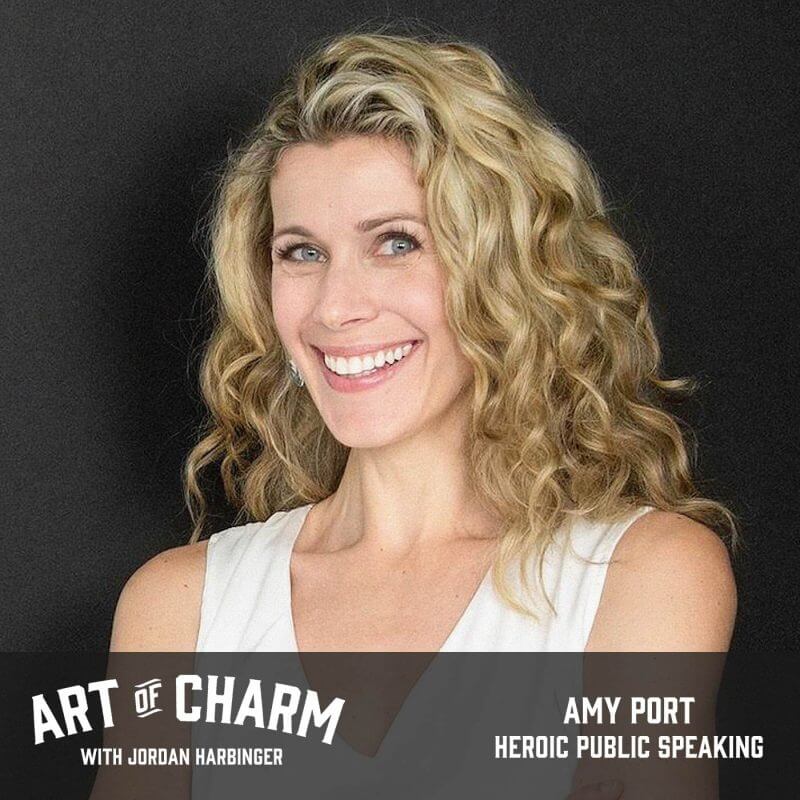If you can learn to tell a good story, you can captivate any audience — whether as a public speaker, while interviewing for a job, or when you’re on a date.
“If there’s one big piece of advice that I have — albeit I have a lot of them — it’s: make sure that you are driven to tell the story that you’re telling.” -Amy Port
The Cheat Sheet:
- Even the best, most personal story can be lost in the hands of a bad storyteller. (04:26)
- A good story is sculpted around Aristotle’s three-act structure: exposition, conflict, and resolution. (05:59)
- What makes a story funny? (09:53)
- Where do we begin if we know we’re not great storytellers? (14:33)
- What’s your story’s throughline (also, what the heck is a throughline)? (25:36)
- And so much more…
[aoc-subscribe]
Stories are a highly effective tool for teaching, for selling, for connecting with your audience, and for entertaining. They are necessary for stealing the show when you are onstage and for moving people emotionally, intellectually, and physically in whatever way you need to captivate the attention of the room — from sales meetings to job interviews to pitches to first dates.
In this episode of The Art of Charm, we talk to Amy Port, the co-founder — with former guest Michael Port — of Heroic Public Speaking. There, she teaches non-actors the skills that only highly trained actors know, the magic of how to get past the nerves, and how to stop speaking and start performing. Most important: she can teach us how to become excellent storytellers.
More About This Show
“Just because it happened to you doesn’t make it interesting.” -Dr. Luther Waxling
Are you a good storyteller? If you’ve lived a life filled with unforgettable experiences, you may think it automatically qualifies you to convey those experiences to others in an equally unforgettable way. After all, storytelling is just a natural extension of living an interesting life, right?
Unless we naturally possess the rare gift of being able to tell good stories, chances are pretty decent that we’re not as adept at it as we think we are. In fact, it’s possible we’ve been bad storytellers our whole lives and people have just been too polite to say anything!
Some of the world’s best storytellers don’t live lives that are any more extraordinary than yours, but they spend a lot of time honing their craft to be extraordinary storytellers. Sometimes the stories they tell aren’t even from their own experiences, but they’re so good at telling these stories that we’re compelled to forget this fact and just enjoy the ride.
We call these people actors.
Before co-founding Heroic Public Speaking with Steal the Show author Michael Port, Amy Port spent years acting professionally in theaters such as Seattle Repertory, Oregon Shakespeare, and Yale Rep, and worked consistently in commercials. She earned her MFA in Acting from the Yale School of Drama, taught acting and movement work in summer sessions at Northwestern University, and has spent the last 15 years mentoring teachers and speakers in bringing the hard skills of performance to their craft.
Amy’s had so much practice in becoming a good storyteller that she can spot bad storytelling from three community theaters away — and she can help us steer away from the habits that make it happen.
For instance, stories told by people who have no stake in their outcome are seldom interesting. And when a storyteller gives us the impression that their story will conclude with something funny and it falls flat, nobody wins — not the storyteller who went through the trouble of telling it, and not the audience who had to sit through its telling.
Sometimes a storyteller will be long-winded, filling in unnecessary details and going off on tangents that have no bearing on the story’s conclusion. Other times, a storyteller will preface what they’re about to tell you with the words, “to make a long story short…” which may seem merciful at first, but what comes out may be less of a story and more of a context-free punchline that is ultimately meaningless.
“If we’re going to tell a story, a) they need to be good stories, and b) they need to be stories that give the people who are listening a deeper understanding of what it is we’re presenting on,” says Amy.
The Three-Act Structure
Sometimes the makings of a good story just suffer from a storyteller’s lack of understanding how to piece them together into a cohesive whole. Luckily, Aristotle — one of the world’s oldest storytellers — whipped up a handy formula over 2,000 years ago that holds true for the stories we tell today. A well-sculpted story builds upon a three-act structure following the processes of exposition, conflict, and resolution.
Think of your favorite books, plays, and movies. Chances are pretty good that the stories you remember best follow this structure, whether penned by William Shakespeare or Stephen King.
“The first act is the exposition, and basically it’s the details,” says Amy. “It’s, well, what do I need to know for this story to even make sense? Well, I need to know the people. I need to know a little bit of the context. A little bit about the relationships. Sometimes you need to know time and place. But it’s what you see in the beginning of any movie or any play — any bit of theater. We have to know enough about what’s going on in the world we’re in for it to make sense.
“If we jump into a story that has us in huge conflict, but we don’t know who the heck the people are or why we should care, then it doesn’t matter. So that’s the first part — we say the first act in the three-act structure.”
“Then we can get to the conflict, which is the second act in the three-act structure. It’s where everything goes wrong, and that should be the heart of every story. Sometimes it’s one big conflict. And sometimes it’s conflict after conflict. It’s things not working out the way the people involved want them to. Or something dramatic happening that screws everybody up.”
“If there is no conflict, then we don’t care and there are no stakes. If there’s nothing that we risk; if there’s nothing that we might potentially miss out on, then there are no stakes — and that’s not interesting, either.”
Finally, Amy says, “There has to be a resolution. Often you see — oh, I want to say foreign films that have no resolution! I don’t know why I want to say that, because I’ve seen so many great foreign films, too, that end beautifully. But on the flip side of it, you see all the Hollywood films where everything wraps up so neat and clean at the end. And sometimes in foreign films, things are left much more open.”
“But for a story to work, we do need there to be a resolution of some kind. It doesn’t have to be a happy ending, right? It doesn’t have to be neat and clean. It doesn’t have to be Hollywood, and often we don’t want it to be, but some kind of pulling together of the loose ends. It’s deeply unsatisfying when we see a film or a play or listen to a friend telling a story and it kind of peters off, where there isn’t a wrapping up of the loose ends.”
“The three-act structure’s like a cheat sheet on how to tell a good story. Give it the three parts; make sure that they are there in balance, meaning that the exposition’s not too long, that the conflict is the major part of the story, and that there is a resolution.”
Listen to this episode of The Art of Charm in its entirety to hear Amy Port’s advice on sourcing stories from unlikely places, streamlining your stories to make sure every detail matters for the throughline, learning the two-story joke-telling formula, and lots more — including the story about that time her business partner Michael Port proposed to her!
THANKS, AMY PORT!
Resources from this episode:
Heroic Public Speaking
Steal the Show by Michael Port
You’ll also like:
- The Art of Charm Challenge (click here or text 38470 in the US)
- The Art of Charm Bootcamps
- Best of The Art of Charm Podcast
- The Art of Charm Toolbox
- The Art of Charm Toolbox for Women
- Find out more about the team who makes The Art of Charm podcast here!
On your phone? Click here to write us a well-deserved iTunes review and help us outrank the riffraff!




